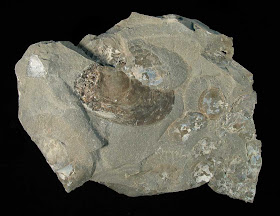These two images are what I think are Callianopsis clallamensis shrimp fossil claws. They might also be referred to as ghost or mud shrimp. Fossils are from the Washington state area and could be from either the Lincoln Creek or Pysht formations. The date of the fossils is to the Oligocene epoch of the Paleogene Period. The fossils were acquired by my cousin in a trade of fossils from the Louisville Kentucky area on a recent visit to the area.
Learn more about fossils from that area of Washington state, USA as this nice crab fossil web site: www.fossilcrabs.com
Thanks to Teri for the pictures.
Pages
▼
Friday, August 17, 2012
Thursday, August 16, 2012
Mystery Gastropod Fossils from Romania
Salut! These pictures show gastropod fossils found in Romania. They are from a region that use to be the Sarmatic Sea which I think is Miocene in age (5-7 million years ago).
What their names are is a mystery to me. So if there are any fossil detectives out there and you can solve this naming enigma... let me know. Mulţumesc!
Thanks to Stanca for the pictures.
What their names are is a mystery to me. So if there are any fossil detectives out there and you can solve this naming enigma... let me know. Mulţumesc!
Thanks to Stanca for the pictures.
Wednesday, August 15, 2012
Cornulites proprius on a Platystoma Fossil
Pictured are several Silurian Waldron Shale fossils. It appears to be the fossilized habitat of a Cornulites proprius attached to the gastropod Platyostoma niagarense. This ensemble was found in Clark County, Indiana. While snail/worm fossil combos are found quite a bit in the Shelby County, Indiana, my experience is they are not quite as common in the more southern county of Clark in Indiana.
Fossils have not been prepped yet so I am hoping for better detail once they are cleaned.
Fossils have not been prepped yet so I am hoping for better detail once they are cleaned.
Monday, August 13, 2012
Pyrite/Marcasite Silurian Fossils
All these fossils were found in the Waldron Shale of Clark County, Indiana. All contain pyrite or marcasite minerals. These first two pictures show the iron sulfide clusters embedded in a Silurian Period brachiopod Homoespirifer evax.
The next two pictures show a segment of byrozoan encrusted with pyrite.
The last two pictures do not this fossil pairing justice. It is a crinoid stem that has another crinoid holdfast wrapped around the stem. Both are encrusted with pyrite or marcasite. A nice photo of one these crinoid ensembles at the Falls of the Ohio State Park web site: CLICK HERE.
The next two pictures show a segment of byrozoan encrusted with pyrite.
The last two pictures do not this fossil pairing justice. It is a crinoid stem that has another crinoid holdfast wrapped around the stem. Both are encrusted with pyrite or marcasite. A nice photo of one these crinoid ensembles at the Falls of the Ohio State Park web site: CLICK HERE.
Sunday, August 12, 2012
Fluorite? in the Lexington Limestone
I make no claims as to being a mineral expert but I believe these specimens are fluorite mixed with calcite or some other mineral (dolomite?). They were found with Cyclonema sp. snail fossils in Franklin County, Kentucky. The layer should be the Lexington Limestone of the Ordovician Period.
The majority of the fluorite is yellow but one has a small section of purple. I find it unique as typically think of the fluorite areas of the state of Kentucky to the western part near southern Illinois.
Mindat.org lists fluorite, calcite, and dolomite as all being found in Franklin County, Kentucky.
Friday, August 10, 2012
Carbonaceous Filmed Pelecypod Fossil
This interesting fossil is some sort of clam preserved by carbonaceous film. It was found in the Lexington Limestone of Franklin County, Kentucky. The name might be a Psiloconcha sp. If you look at the picture of the matrix plate, it was fossilized in place with a number of other sea creatures. In addition, a brachiopod imprint appears in the matrix as well. Also the clam might have some calcite crystals at one end of it.
Thanks to Lawrence for these fossils.
Sunday, August 5, 2012
Coiled Crinoid Holdfast/Arm
At first glance, this fossil looks like a coiled up millipede or some sort of worm. This coiled crinoid holdfast was probably used by the creature to anchor itself on the seafloor so it would not float away. It was found near railroad tracks in Indianapolis, Indiana. If I had to guess, it is probably from the Mississippian Period.
Thanks to Daniel for sharing this picture.
Thanks to Daniel for sharing this picture.





















